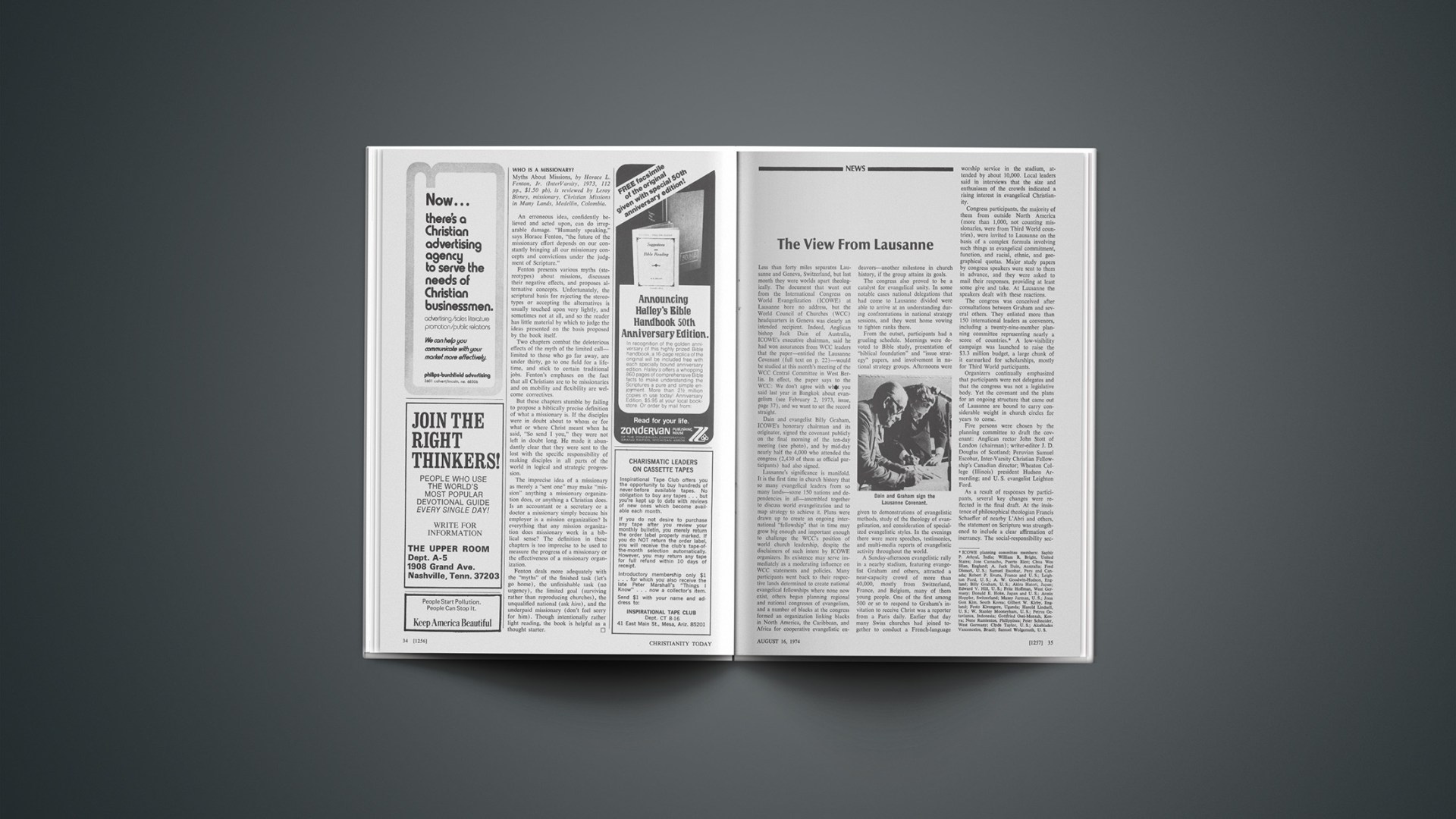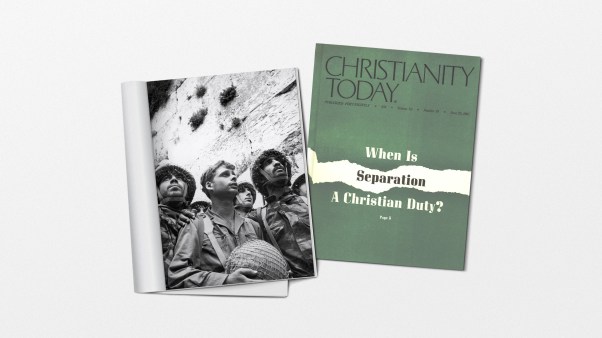Less than forty miles separates Lausanne and Geneva, Switzerland, but last month they were worlds apart theologically. The document that went out from the International Congress on World Evangelization (ICOWE) at Lausanne bore no address, but the World Council of Churches (WCC) headquarters in Geneva was clearly an intended recipient. Indeed, Anglican bishop Jack Dain of Australia, ICOWE’s executive chairman, said he had won assurances from WCC leaders that the paper—entitled the Lausanne Covenant (full text on p. 22)—would be studied at this month’s meeting of the WCC Central Committee in West Berlin. In effect, the paper says to the WCC: We don’t agree with what you said last year in Bangkok about evangelism (see February 2, 1973, issue, page 37), and we want to set the record straight.
Dain and evangelist Billy Graham, ICOWE’s honorary chairman and its originator, signed the covenant publicly on the final morning of the ten-day meeting (see photo), and by mid-day nearly half the 4,000 who attended the congress (2,430 of them as official participants) had also signed.
Lausanne’s significance is manifold. It is the first time in church history that so many evangelical leaders from so many lands—some 150 nations and dependencies in all—assembled together to discuss world evangelization and to map strategy to achieve it. Plans were drawn up to create an ongoing international “fellowship” that in time may grow big enough and important enough to challenge the WCC’s position of world church leadership, despite the disclaimers of such intent by ICOWE organizers. Its existence may serve immediately as a moderating influence on WCC statements and policies. Many participants went back to their respective lands determined to create national evangelical fellowships where none now exist, others began planning regional and national congresses of evangelism, and a number of blacks at the congress formed an organization linking blacks in North America, the Caribbean, and Africa for cooperative evangelistic endeavors—another milestone in church history, if the group attains its goals.
The congress also proved to be a catalyst for evangelical unity. In some notable cases national delegations that had come to Lausanne divided were able to arrive at an understanding during confrontations in national strategy sessions, and they went home vowing to tighten ranks there.
From the outset, participants had a grueling schedule. Mornings were devoted to Bible study, presentation of “biblical foundation” and “issue strategy” papers, and involvement in national strategy groups. Afternoons were given to demonstrations of evangelistic methods, study of the theology of evangelization, and consideration of specialized evangelistic styles. In the evenings there were more speeches, testimonies, and multi-media reports of evangelistic activity throughout the world.
A Sunday-afternoon evangelistic rally in a nearby stadium, featuring evangelist Graham and others, attracted a near-capacity crowd of more than 40,000, mostly from Switzerland, France, and Belgium, many of them young people. One of the first among 500 or so to respond to Graham’s invitation to receive Christ was a reporter from a Paris daily. Earlier that day many Swiss churches had joined together to conduct a French-language worship service in the stadium, attended by about 10,000. Local leaders said in interviews that the size and enthusiasm of the crowds indicated a rising interest in evangelical Christianity.
Congress participants, the majority of them from outside North America (more than 1,000, not counting missionaries, were from Third World countries), were invited to Lausanne on the basis of a complex formula involving such things as evangelical commitment, function, and racial, ethnic, and geographical quotas. Major study papers by congress speakers were sent to them in advance, and they were asked to mail their responses, providing at least some give and take. At Lausanne the speakers dealt with these reactions.
The congress was conceived after consultations between Graham and several others. They enlisted more than 150 international leaders as convenors, including a twenty-nine-member planning committee representing nearly a score of countries.1ICOWE planning committee members: Saphir P. Athyal, India; William R. Bright, United States; Jose Camacho, Puerto Rico; Chua Wee Hian, England; A. Jack Dain, Australia; Fred Dienert, U. S.; Samuel Escobar, Peru and Canada; Robert P. Evans, France and U. S.; Leighton Ford, U. S.; A. W. Goodwin-Hudson, England; Billy Graham, U. S.; Akira Hatori, Japan; Edward V. Hill, U. S.; Fritz Hoffman, West Germany; Donald E. Hoke, Japan and U. S.; Armin Hoppler, Switzerland; Maxey Jarman, U. S.; Joon Gon Kim, South Korea; Gilbert W. Kirby, England; Festo Kivengere, Uganda; Harold Lindsell, U. S.; W. Stanley Mooneyham, U. S.; Petrus Octavianus, Indonesia; Gottfried Osei-Mensah, Kenya; Nene Ramientos, Philippines; Peter Schneider, West Germany; Clyde Taylor, U. S.; Alcebiades Vasconcelos, Brazil; Samuel Wolgemuth, U. S. A low-visibility campaign was launched to raise the $3.3 million budget, a large chunk of it earmarked for scholarships, mostly for Third World participants.
Organizers continually emphasized that participants were not delegates and that the congress was not a legislative body. Yet the covenant and the plans for an ongoing structure that came out of Lausanne are bound to carry considerable weight in church circles for years to come.
Five persons were chosen by the planning committee to draft the covenant: Anglican rector John Stott of London (chairman); writer-editor J. D. Douglas of Scotland; Peruvian Samuel Escobar, Inter-Varsity Christian Fellowship’s Canadian director; Wheaton College (Illinois) president Hudson Armerding; and U. S. evangelist Leighton Ford.
As a result of responses by participants, several key changes were reflected in the final draft. At the insistence of philosophical theologian Francis Schaeffer of nearby L’Abri and others, the statement on Scripture was strengthened to include a clear affirmation of inerrancy. The social-responsibility section was intensified, putting signers on record as affirming that “evangelism and socio-political involvement are both part of our Christian duty.” Added to the statement on evangelistic urgency was an indirect reference to the missionary moratorium issue (see June 7 issue, page 45), as raised by some African blacks: “a reduction of foreign missionaries and money in an evangelized country may sometimes be necessary to facilitate the national church’s growth in self-reliance and to release resources for unevangelized areas.” Also, a new introduction was added to the church partnership section: “We rejoice that a new missionary era has dawned. The dominant role of western missions is fast disappearing.”
An entirely new section was added on freedom and persecution in response to a resolution from a sixty-member strategy group dealing with evangelism in countries whose governments are hostile to Christianity.
Meanwhile there was no toning down of the covenant’s strongly worded rejection of universalism, syncretism, and the premise that social action and political liberation can be construed as evangelism. (Favorable references to all these concepts can be found in public statements of the WCC or its leaders over the past few years.)
For a while it appeared that the proposal for an ongoing fellowship might split the participants. Some Latin American and African leaders suspected a “hidden agenda” aimed at creating an opposing parallel organization to the WCC. Not so, Dain asserted several times from the podium. Of more than 1,000 who responded to a questionnaire, he said, 86 per cent indicated they wanted some kind of ongoing “fellowship” to keep the spirit and purpose of Lausanne alive, and 79 per cent approved the establishment of a thirty-member Continuation Committee.
Indeed, in preliminary papers that had been mailed months ago to participants several speakers called for such an association, and, said Dain, many advance responses from participants expressed a similar wish. Unconvinced, several leaders engaged in corridor politicking in apparent hopes of creating enough dissent to get the ICOWE planners to quash the idea. They failed, and plans moved ahead.
In national and regional caucuses participants nominated 102 persons. For the Continuation Committee the planning committee will select twenty-five of these (plus five others on or off the list) as follows: one each from Oceania and the Middle East; three each from Central-West Asia, East Asia, Africa, and Latin America; five from Europe; and six from North America. The Continuation Committee probably will establish an executive office to link national and regional post-Lausanne fellowships.
Another document, “A Response to Lausanne,” came from a rump session (there were many) on radical discipleship attended by several hundred who felt the congress had not said enough on Christian social responsibility. Its point: “There is no biblical dichotomy between the word spoken and the word made visible in the lives of God’s people.” The planning committee permitted distribution of the statement to participants.
Many dismissed the paper as superfluous. The social-responsibility theme in fact was given heavy emphasis not only in the covenant but also in plenary presentations. Its two most vocal advocates perhaps were Escobar and C. Rene Padilla, an executive of the Latin American branch of the International Fellowship of Evangelical Students. Both men seemed more popular among Anglo-Saxons than among their Latin peers, who declined to nominate them to the Continuation Committee. At one impromptu meeting of about 100 Latins, Escobar spoke critically of missionary relationships in Latin America, and he was promptly rebuked by a dozen leaders who said they not only rejected the idea of a moratorium but also would welcome all the missionaries they could get.
The moratorium issue arose in the East Africa National Strategy group, composed of about sixty representatives from Kenya, Tanzania, and Uganda. In that group was an ICOWE convenor, John Gatu, executive head of the Presbyterian Churches of East Africa and president of the Central Committee of the All Africa Conference of Churches (AACC), who issued the call for a moratorium on Western missionaries and money at the recent AACC meeting in Lasaka, Zambia. (Moratorium hit the headlines in 1972 when delegates to the WCC Conference on Salvation held in Bangkok called for it.) Several of the East Africans, including well respected Anglican bishop Festo Kivengere of Uganda, said they felt the group needed to say something because of all the bad press and negative understanding attached to the word. Debate was spirited but calm and reasonable. (In an interview later, Kivengere said the AACC had not really represented grass-roots sentiment; the Lusaka statement, he said, was occasioned by the paternalism of some missionaries.)
In the debate Gatu reasserted his belief that a meaningful partnership with Western missionaries is impossible because they regard Africans as ecclesiastical children. The only way to break the back of paternalism is through a moratorium, he argued. Former Anglican archbishop Erica Abiti of Uganda and Bishop Henry Okullu of Uganda led the opposition. A compromise statement was finally approved:
Although the idea of moratorium has been recommended to the churches in Africa, the churches have not yet discussed the recommendations or approved it. Therefore the impression that the churches in Africa have already declared moratorium is misleading. It is however important to recognize that the idea behind moratorium is concerned about over-dependence upon foreign resources both personnel and finances, which sometimes hinders initiative and development of local responsibility. [Our] group felt that the application of the concept behind moratorium might be considered for specific situations rather than generally.
Meanwhile, several platform personalities, including Graham, criticized the call for a moratorium. But all things considered, the emergence of the moratorium issue and the timing of the ICOWE may be of deep significance in the history of evangelicalism. Many Westerners at the congress said that they were impressed by the zeal and competence of the Third World Christians and that they no longer fear for the future of the churches if the missionaries must leave. They said they now see their Third World counterparts as full partners in the task of world evangelism and no longer as objects of special aid or as international subsidiaries to be looked after.
Wef: Is There A Future?
Immediately following the International Congress on World Evangelization (ICOWE) at Lausanne, Switzerland, some sixty of the leaders there traveled to the nearby mountain resort of Chateau D’Oex for the Sixth General Assembly of the World Evangelical Fellowship (WEF). Normally the WEF assembly is held every four years, but because of lagging finances it had not convened since the Fifth Assembly in 1968 in Lausanne.
In light of the time gap, the implications of the ICOWE, and the pending retirement of Clyde Taylor as the WEF’s international executive secretary, the Sixth Assembly was a crucial one. But the delegates got bogged down in revising the WEF constitution. Many of them left early, including some who had important roles in the ICOWE, and as a result little was accomplished. Left undiscussed were the purpose and the future of the WEF, especially important in view of the ICOWE’s plans to create a Continuation Committee aimed at linking the world’s evangelicals—inside and outside the mainline denominations—in evangelism.
Anglican John Stott, president of the Evangelical Alliance of Great Britain (a WEF member organization) and a drafter of the ICOWE Lausanne Covenant, said in an interview that the WEF must radically restructure itself to enable a de facto merger with whatever develops from the ICOWE Continuation Committee. Otherwise, he said, the WEF “may as well commit hari-kari.”
Taylor privately envisions the Continuation Committee as possibly the evangelism commission of the WEF, but ICOWE executive Donald Hoke dismisses the notion. The WEF, he implies, is too narrow in theology and policy to appeal to many whom the ICOWE leaders hope to attract, and half of those present at the ICOWE were unfamiliar with it, he said.
Meanwhile, a multi-national conservative bloc in the WEF, espousing a we-were-here-first line, is opposed to any restructure that will compromise present membership policy or will in effect dismantle the WEF.
In passing the revised constitution, WEF leaders nevertheless said they were open to negotiation with the ICOWE committee. Wheaton College president Hudson Armerding was elected WEF president. Other officers are Stephen Damaris of Indonesia; Byang Kato, head of the Association of Evangelicals of Africa and Madagascar; Gordon Landreth, executive secretary of the Evangelical Alliance of Great Britain; Anglican bishop Jack Dain of Australia (the ICOWE executive chairman); Claude Noel of Haiti; and C. C. Rema of India.
A 1975 budget of $81,500 was approved. This amount includes $35,000 that must be raised in a special supplemental campaign, and it does not include anything for a new international secretary (Taylor is staked by the U. S. National Association of Evangelicals).
The WEF is made up of about two dozen national fellowships of evangelicals plus several other groups. Its roots go back to 1846, when the Evangelical Alliance of Great Britain was founded. The movement spread to continental Europe and became known as the World Evangelical Alliance (WEA). The WEA became the WEF in 1951. Some in Europe complained that the new group was too fundamentalist, and in 1952 they formed the European Evangelical Alliance (EEA). With the years came mellowing, and today most of the EEA members are also members of the WEF.
EDWARD E. PLOWMAN
Slapping The Wcc Wrist
In a “gesture of criticism” the Church of England General Synod voted to reduce the church’s contribution to the World Council of Churches by $2,400. This protest against some WCC activities—“particularly its controversial grants to liberation movements”—was made at the synod’s summer meeting, held at York University.
Debate on the $41,760 earmarked for the WCC was at times heated. Some synod members seemed to think that the grant should be cut by half. “One rarely opens a daily newspaper without seeing some fresh idiocy of the WCC,” said one. Another compared the liberation movements under criticism with the Irish Republican Army. Cooling things down a little, Oliver Tomkins, bishop of Bristol, claimed that media reporting of the work of the WCC was always highly selective.
It was left to the Reverend Christopher Wansey to move that the synod should “just chop off a thousand pounds.” It was not right to withdraw support from an organization simply because one aspect of its work gave cause for concern, he said. The motion was approved 181 to 138.
A warning that in the coming years inflation may strip the church of its possessions came from Donald Coggan, archbishop of York, in his presidential address to the General Synod.
Coggan, who will become Archbishop of Canterbury in January, 1975, urged the church to assume a prophetic role in the present crisis of inflation. Necessary first of all, he said, is a change in man’s attitude toward work: now he works merely to acquire, instead of from a sense of vocation.
The synod voted itself a decisive voice in appointing bishops, until now left to the state. The legal, administrative, and constitutional implications of this decision were left unclear.
The synod committed the church to full participation in the proposed Church Unity Commission, whose eventual aim is union involving Anglican, Methodist, and United Reformed Churches in Britain.
DAVID COOMES
Endangered Species
The Anglican diocese of Toronto by a 248–18 vote asked the Anglican Church of Canada to renegotiate the terms of the Basis of Union designed to merge the Anglicans with the United Church of Canada and the Christian Church (Disciples of Christ). The diocese was responding to the criticisms of Bishop L. S. Garnsworthy, who charged that the new church’s bishops would be “emasculated relics of all we have believed about episcopacy.” He added that “the bishop emerges as yet another personnel officer, denuded of marks of episcopacy.”
The Toronto diocese is the most influential and wealthy in Canada, and its action has had a chilling effect on church-union enthusiasts. (According to the present union plan the new church would have about four million members and 100 bishops. The Anglican Church now has twenty-eight diocesan bishops and a few suffragans.)
LESLIE K. TARR








